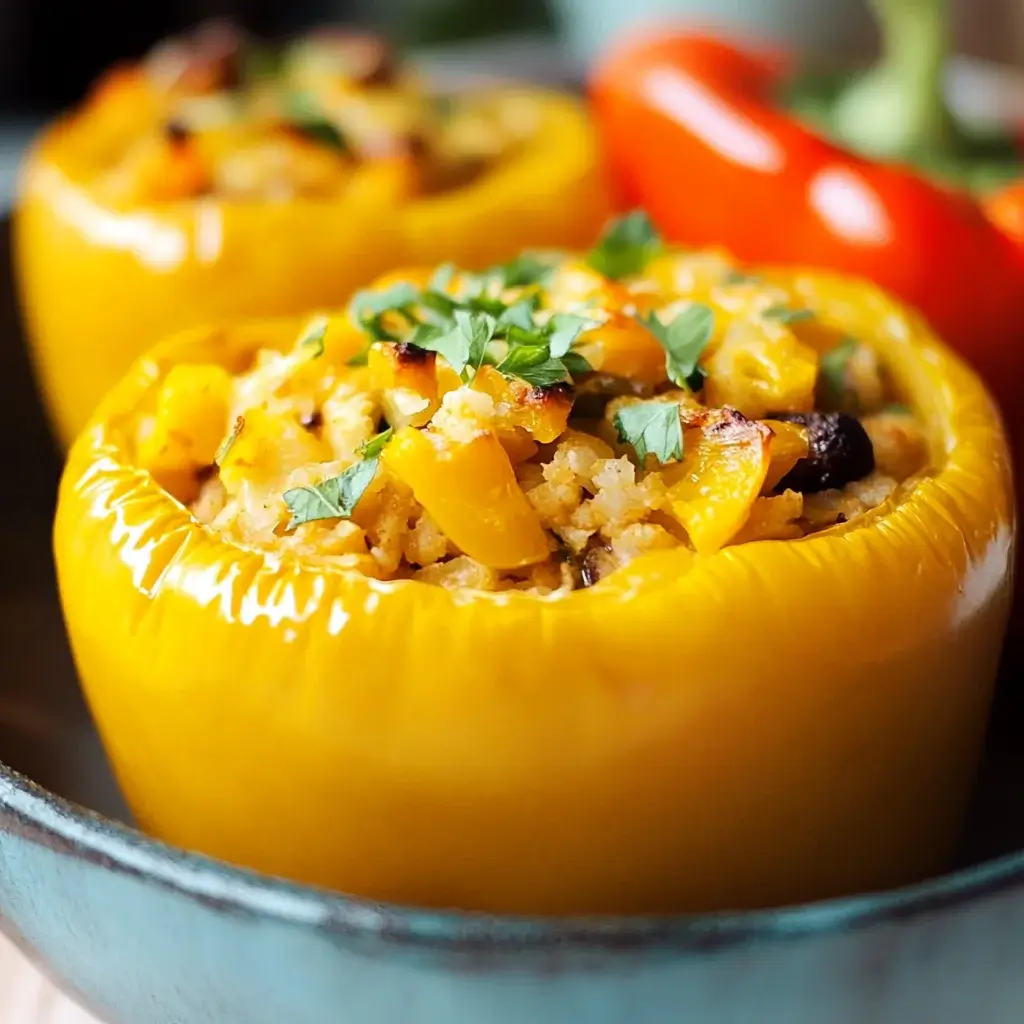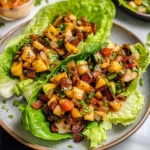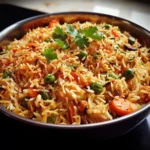My family absolutely adores stuffed peppers, but for years, they were a somewhat heavier, meat-centric dish in our rotation. When I decided to embrace more plant-based meals, I knew I had to create a vegan version that would be just as satisfying and flavorful – and let me tell you, this recipe exceeded all expectations! These Vegan Stuffed Peppers are bursting with savory goodness, packed with wholesome ingredients, and surprisingly easy to make. Even my meat-loving family members request these regularly now. The vibrant colors and aromatic spices make them a feast for the eyes and the taste buds. Whether you’re a seasoned vegan, a curious vegetarian, or simply looking to incorporate more vegetables into your diet, this recipe is a guaranteed crowd-pleaser. Get ready to experience a comforting and healthy meal that will become a new family favorite!
Ingredients
- Bell Peppers: 6 large bell peppers, choose your favorite colors (red, yellow, orange, green) for visual appeal and varied flavors.
- Cooked Rice: 2 cups cooked brown rice or quinoa, providing a hearty and nutritious base for the filling.
- Black Beans: 1 (15-ounce) can black beans, rinsed and drained, adding protein and fiber to the stuffing.
- Corn: 1 cup frozen or canned corn kernels, thawed if frozen, lending sweetness and texture.
- Diced Tomatoes: 1 (14.5-ounce) can diced tomatoes, undrained, contributing moisture and acidity to the filling.
- Onion: 1 medium yellow onion, finely chopped, forming the aromatic foundation of the flavor base.
- Garlic: 3 cloves garlic, minced, enhancing the savory depth of the dish.
- Vegetable Broth: 1 cup vegetable broth, low sodium, used for cooking the peppers and adding moisture.
- Olive Oil: 2 tablespoons olive oil, used for sautéing vegetables and adding richness.
- Spices: 1 tablespoon chili powder, 1 teaspoon cumin, 1 teaspoon smoked paprika, ½ teaspoon oregano, ¼ teaspoon red pepper flakes (optional), salt and black pepper to taste, creating a warm and flavorful spice blend.
- Vegan Cheese Shreds (optional): ½ cup vegan cheese shreds, for topping and adding a melty, cheesy element.
- Fresh Cilantro (optional): ¼ cup chopped fresh cilantro, for garnish and a fresh herbal note.
Instructions
- Prepare the Peppers: Preheat your oven to 375°F (190°C). Wash the bell peppers thoroughly. Carefully slice off the tops of the peppers and remove the seeds and membranes from inside. Set the pepper tops aside if you wish to use them as lids later (optional).
- Sauté Aromatics: Heat olive oil in a large skillet over medium heat. Add the chopped onion and cook until softened, about 5 minutes. Add the minced garlic and cook for another minute until fragrant, being careful not to burn the garlic.
- Combine Filling Ingredients: To the skillet with the onions and garlic, add the cooked rice or quinoa, black beans, corn, diced tomatoes (undrained), chili powder, cumin, smoked paprika, oregano, red pepper flakes (if using), salt, and black pepper. Stir well to combine all ingredients.
- Simmer Filling: Pour in ½ cup of vegetable broth into the skillet. Bring the mixture to a simmer and cook for 5-7 minutes, allowing the flavors to meld together and the mixture to slightly thicken. Taste and adjust seasonings as needed.
- Stuff the Peppers: Stand the bell peppers upright in a baking dish. Spoon the prepared filling evenly into each pepper, packing it gently. If using, place the reserved pepper tops back on the stuffed peppers or leave them open.
- Bake the Peppers: Pour the remaining ½ cup of vegetable broth into the bottom of the baking dish. This will help steam the peppers and prevent them from drying out. Cover the baking dish with aluminum foil.
- Bake Covered: Bake in the preheated oven for 30 minutes, covered.
- Bake Uncovered (Optional Cheese): Remove the foil and bake for another 15-20 minutes, or until the peppers are tender but still slightly firm, and the filling is heated through. If using vegan cheese, sprinkle it over the top of the stuffed peppers during the last 5-10 minutes of baking, allowing it to melt.
- Rest and Serve: Let the stuffed peppers rest for a few minutes before serving. Garnish with fresh cilantro, if desired. Serve hot and enjoy!
Nutrition Facts (per serving, approximate)
(Note: Nutritional values are estimates and can vary based on specific ingredients and portion sizes. Serving size is estimated as one stuffed pepper.)
- Servings: 6
- Calories per Serving: Approximately 350-400 kcal
- Fat: 10-15g
- Saturated Fat: 2-3g
(These values are approximate and for informational purposes only. For precise nutritional information, use a nutrition calculator with the specific brands and quantities of ingredients used.)
Preparation Time
- Prep Time: 30 minutes (includes chopping vegetables, preparing filling, and stuffing peppers)
- Cook Time: 45-50 minutes (baking time)
- Total Time: Approximately 1 hour 15 minutes
This Vegan Stuffed Peppers recipe is wonderfully efficient! The prep work is straightforward, mainly involving chopping vegetables and mixing the filling. Baking time allows for hands-off cooking, making it a great option for weeknight dinners.
How to Serve
These Vegan Stuffed Peppers are a complete and satisfying meal on their own, but you can enhance your dining experience with complementary side dishes and toppings:
- Side Dishes:
- Fresh Salad: A light and refreshing green salad with a vinaigrette dressing provides a crisp contrast to the warm stuffed peppers. Consider a simple mixed greens salad, a cucumber and tomato salad, or a slaw.
- Roasted Vegetables: Serve alongside roasted vegetables like broccoli, asparagus, or Brussels sprouts for an extra boost of nutrients and flavor.
- Garlic Bread: Vegan garlic bread or crusty bread is perfect for soaking up any leftover sauce from the baking dish.
- Creamy Vegan Polenta or Mashed Potatoes: For a heartier meal, serve over a bed of creamy vegan polenta or mashed potatoes.
- Toppings & Garnishes:
- Vegan Sour Cream or Yogurt: A dollop of vegan sour cream or plain vegan yogurt adds coolness and tanginess.
- Avocado or Guacamole: Creamy avocado slices or a spoonful of guacamole adds healthy fats and richness.
- Salsa or Pico de Gallo: Fresh salsa or pico de gallo brings a vibrant and zesty element.
- Hot Sauce: For those who like a spicy kick, a drizzle of your favorite hot sauce is a great addition.
- Fresh Herbs: Garnish with extra fresh cilantro, parsley, or chives for a pop of color and freshness.
- Vegan Parmesan Cheese: Sprinkle with vegan parmesan cheese for an extra savory and cheesy flavor.
Additional Tips for Perfect Vegan Stuffed Peppers
Pepper Selection is Key
When it comes to creating the perfect stuffed peppers, the selection of your bell peppers is crucial. Opt for bell peppers that are not only firm to the touch but also have a vibrant, glossy skin. These characteristics indicate freshness, which enhances the overall flavor of your dish. Choose peppers that can stand upright easily, as this stability is essential for stuffing. Larger peppers, such as the classic green, red, yellow, or orange varieties, provide a more spacious cavity for your fillings, making them easier to stuff and ensuring a well-balanced ratio of pepper to filling.
In addition to size, consider incorporating a mix of colors into your dish. Not only do different colored bell peppers bring an aesthetic appeal to your plate, but they also offer slightly varying flavors and nutritional benefits. For instance, red peppers tend to be sweeter than their green counterparts, while yellow and orange peppers strike a balance between the two. This variety can elevate the taste profile of your stuffed peppers, making each bite an exciting experience.
Don’t Overcook the Peppers
Achieving the perfect texture for your stuffed peppers is a matter of careful timing. When baking the peppers, aim for a tender-crisp texture. This means the skin should be slightly soft but still retain some firmness, allowing the peppers to hold their shape throughout the cooking process. Overcooking can lead to a mushy consistency, which detracts from the overall presentation and enjoyment of the dish. To check for doneness, pierce a pepper with a fork; it should yield easily but still offer some resistance. This delicate balance ensures that the peppers not only look appealing but also provide a satisfying bite.
Customize Your Filling
One of the most exciting aspects of making stuffed peppers is their versatility. The filling can be adapted to suit your taste preferences or utilize ingredients you have on hand, making this dish a fantastic opportunity for creativity in the kitchen. Beyond the classic combination of rice and beans, consider incorporating other vegetables such as zucchini, mushrooms, or spinach to add texture and nutrition. For a heartier filling, you might include ingredients like diced tomatoes, corn, or even cooked lentils.
Don’t be afraid to experiment with different types of beans, such as kidney, pinto, or black beans, each bringing its own unique flavor and texture. You can also add grains like farro or barley for a nutty flavor and chewy texture. The key is to balance flavors and textures to create a filling that complements the sweetness of the peppers while providing a satisfying meal.
Spice it Up (or Tone it Down)
Controlling the spice level in your stuffed peppers is essential to cater to various palates. Adjust the amount of chili powder and red pepper flakes based on your preference for heat. If you enjoy a milder flavor, consider reducing or omitting the red pepper flakes altogether. On the other hand, if you prefer a kick, feel free to amp up the spice by incorporating a pinch of cayenne pepper or even adding a diced jalapeño to the filling. Additionally, consider the use of fresh herbs like cilantro or parsley to enhance the flavor profile without adding heat. This flexibility allows you to tailor the dish to suit your guests or family members, ensuring everyone can enjoy it.
Grain Variations
While brown rice and quinoa are often favored choices for the base of the filling, you can explore a variety of grains to suit your taste and dietary needs. White rice is a classic alternative that offers a lighter texture, while couscous can add a delightful fluffiness. For a protein-rich option, consider using lentils, which can also enhance the filling’s nutritional value. Additionally, experimenting with different types of grains not only alters the flavor and texture but also introduces new nutrients, making your stuffed peppers even more wholesome.
Make-Ahead Magic
Preparing your stuffed peppers in advance can save time on busy weeknights. You can make the filling up to two days ahead and store it in an airtight container in the refrigerator. This not only allows the flavors to meld together but also makes the assembly process quicker when you’re ready to bake. For ultimate convenience, you can even stuff the peppers ahead of time and keep them refrigerated until you’re ready to cook. This way, you can easily pop them in the oven when needed, making dinner a breeze.
Freezing for Future Meals
Vegan stuffed peppers are not only delicious fresh but also freeze exceptionally well, making them a great option for meal prepping. After baking the peppers according to your recipe, allow them to cool completely. Next, individually wrap each stuffed pepper in plastic wrap and then in aluminum foil to protect them from freezer burn. These can be stored in the freezer for up to 2-3 months. When you’re ready to enjoy them again, simply thaw the peppers overnight in the refrigerator and reheat them in the oven or microwave. This method ensures you always have a wholesome meal ready to go, perfect for hectic days.
Broiling for Extra Color
To elevate the visual appeal and flavor of your stuffed peppers, consider broiling them for the last 2-3 minutes of baking. This technique allows the tops of the peppers to become slightly charred and caramelized, creating a delightful contrast with the tender flesh underneath. Keep a close eye on them while broiling, as they can quickly go from perfectly caramelized to burnt. This final touch not only adds an eye-catching golden hue but also introduces a subtle smoky flavor that enhances the overall dish, providing a satisfying finish to your culinary creation.
Frequently Asked Questions (FAQ)
Q1: Can I use different types of beans in the filling?
A: Absolutely! Black beans are a classic choice, but you can easily substitute them with kidney beans, pinto beans, cannellini beans, or even chickpeas. Each type of bean will bring slightly different flavors and textures to the filling.
Q2: I don’t have brown rice or quinoa. Can I use white rice?
A: Yes, white rice will work perfectly fine. Brown rice and quinoa offer more fiber and nutrients, but white rice is a readily available and acceptable substitute. You could also use other grains like couscous or even a blend of grains.
Q3: Can I make these stuffed peppers gluten-free?
A: Yes, this recipe is naturally gluten-free if you use gluten-free grains like rice or quinoa and ensure your vegetable broth and any optional vegan cheese are certified gluten-free.
Q4: What’s a good vegan cheese substitute for topping?
A: There are many great vegan cheese shreds available now. Look for brands that melt well, such as those made from cashew, coconut, or tapioca. Violife, Daiya, and Follow Your Heart are popular brands. You can also skip the cheese entirely if you prefer.
Q5: How do I reheat leftover stuffed peppers?
A: Leftover stuffed peppers can be reheated in the oven at 350°F (175°C) for about 15-20 minutes, or until heated through. You can also microwave them for a quicker reheat, but the texture might be slightly softer.
Q6: Can I add meat substitutes to make this more like a traditional stuffed pepper?
A: While this recipe is designed to be vegan and vegetarian, you could add plant-based crumbles or vegan sausage to the filling if you desire a heartier, more “meaty” texture. Ensure the meat substitute you choose is vegan if you want to maintain the vegan aspect of the recipe.
Q7: My filling seems a little dry. What can I do?
A: If your filling seems dry before stuffing the peppers, add a little more vegetable broth or diced tomatoes (with their juice) to moisten it. You can also add a tablespoon or two of tomato paste for extra moisture and flavor.
Q8: Can I use green bell peppers only? Are they less sweet?
A: Yes, you can definitely use only green bell peppers. Green bell peppers are indeed less sweet and have a slightly more bitter flavor compared to red, yellow, and orange peppers. If you prefer a milder, sweeter stuffed pepper, using a mix of colors or solely sweeter peppers might be preferable. However, green peppers are perfectly delicious and work wonderfully in this recipe if you enjoy their taste!






